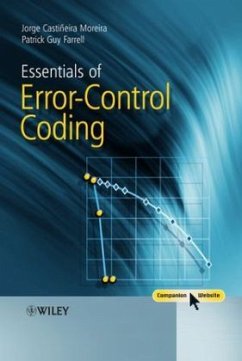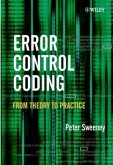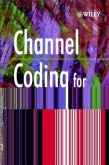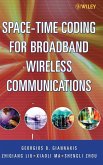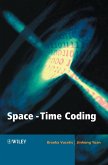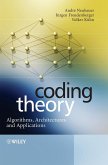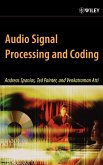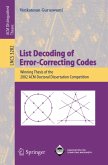- Gebundenes Buch
- Merkliste
- Auf die Merkliste
- Bewerten Bewerten
- Teilen
- Produkt teilen
- Produkterinnerung
- Produkterinnerung
Rapid advances in electronic and optical technology have enabled the implementation of powerful error-control codes, which are now used in almost the entire range of information systems with close to optimal performance. These codes and decoding methods are required for the detection and correction of the errors and erasures which inevitably occur in digital information during transmission, storage and processing because of noise, interference and other imperfections.
Error-control coding is a complex, novel and unfamiliar area, not yet widely understood and appreciated. This book sets out…mehr
Andere Kunden interessierten sich auch für
![Error Control Coding Error Control Coding]() Peter SweeneyError Control Coding85,99 €
Peter SweeneyError Control Coding85,99 €![Channel Coding for Telecommunications Channel Coding for Telecommunications]() Martin BossertChannel Coding for Telecommunications281,99 €
Martin BossertChannel Coding for Telecommunications281,99 €![Space-Time Coding for Broadband Wireless Communications Space-Time Coding for Broadband Wireless Communications]() Georgios B. GiannakisSpace-Time Coding for Broadband Wireless Communications151,99 €
Georgios B. GiannakisSpace-Time Coding for Broadband Wireless Communications151,99 €![Space-Time Coding Space-Time Coding]() Branka VuceticSpace-Time Coding167,99 €
Branka VuceticSpace-Time Coding167,99 €![Coding Theory Coding Theory]() Andre NeubauerCoding Theory147,99 €
Andre NeubauerCoding Theory147,99 €![Audio Signal Processing and Coding Audio Signal Processing and Coding]() Andreas SpaniasAudio Signal Processing and Coding175,99 €
Andreas SpaniasAudio Signal Processing and Coding175,99 €![List Decoding of Error-Correcting Codes List Decoding of Error-Correcting Codes]() Venkatesan GuruswamiList Decoding of Error-Correcting Codes41,99 €
Venkatesan GuruswamiList Decoding of Error-Correcting Codes41,99 €-
-
-
Rapid advances in electronic and optical technology have enabled the implementation of powerful error-control codes, which are now used in almost the entire range of information systems with close to optimal performance. These codes and decoding methods are required for the detection and correction of the errors and erasures which inevitably occur in digital information during transmission, storage and processing because of noise, interference and other imperfections.
Error-control coding is a complex, novel and unfamiliar area, not yet widely understood and appreciated. This book sets out to provide a clear description of the essentials of the subject, with comprehensive and up-to-date coverage of the most useful codes and their decoding algorithms. A practical engineering and information technology emphasis, as well as relevant background material and fundamental theoretical aspects, provides an in-depth guide to the essentials of Error-Control Coding.
_ Provides extensive and detailed coverage of Block, Cyclic, BCH, Reed-Solomon, Convolutional, Turbo, and Low Density Parity Check (LDPC) codes, together with relevant aspects of Information Theory
_ Presents EXIT chart performance analysis for iteratively decoded error-control techniques
_ Heavily illustrated with tables, diagrams, graphs, worked examples, and exercises
_ Includes an invaluable companion website featuring slides of figures, algorithm software, updates and solutions to problems
Offering a complete overview of Error Control Coding, this book is an indispensable resource for students, engineers and researchers in the areas of telecommunications engineering, communication networks, electronic engineering, computer science, information systems and technology, digital signal processing and applied mathematics.
Hinweis: Dieser Artikel kann nur an eine deutsche Lieferadresse ausgeliefert werden.
Error-control coding is a complex, novel and unfamiliar area, not yet widely understood and appreciated. This book sets out to provide a clear description of the essentials of the subject, with comprehensive and up-to-date coverage of the most useful codes and their decoding algorithms. A practical engineering and information technology emphasis, as well as relevant background material and fundamental theoretical aspects, provides an in-depth guide to the essentials of Error-Control Coding.
_ Provides extensive and detailed coverage of Block, Cyclic, BCH, Reed-Solomon, Convolutional, Turbo, and Low Density Parity Check (LDPC) codes, together with relevant aspects of Information Theory
_ Presents EXIT chart performance analysis for iteratively decoded error-control techniques
_ Heavily illustrated with tables, diagrams, graphs, worked examples, and exercises
_ Includes an invaluable companion website featuring slides of figures, algorithm software, updates and solutions to problems
Offering a complete overview of Error Control Coding, this book is an indispensable resource for students, engineers and researchers in the areas of telecommunications engineering, communication networks, electronic engineering, computer science, information systems and technology, digital signal processing and applied mathematics.
Hinweis: Dieser Artikel kann nur an eine deutsche Lieferadresse ausgeliefert werden.
Produktdetails
- Produktdetails
- Verlag: Wiley & Sons
- 1. Auflage
- Seitenzahl: 360
- Erscheinungstermin: 1. Oktober 2006
- Englisch
- Abmessung: 246mm x 174mm x 27mm
- Gewicht: 865g
- ISBN-13: 9780470029206
- ISBN-10: 047002920X
- Artikelnr.: 20870293
- Herstellerkennzeichnung
- Libri GmbH
- Europaallee 1
- 36244 Bad Hersfeld
- gpsr@libri.de
- Verlag: Wiley & Sons
- 1. Auflage
- Seitenzahl: 360
- Erscheinungstermin: 1. Oktober 2006
- Englisch
- Abmessung: 246mm x 174mm x 27mm
- Gewicht: 865g
- ISBN-13: 9780470029206
- ISBN-10: 047002920X
- Artikelnr.: 20870293
- Herstellerkennzeichnung
- Libri GmbH
- Europaallee 1
- 36244 Bad Hersfeld
- gpsr@libri.de
Jorge Castiñera Moreira is Associate Professor (Senior Lecturer) in Communication Systems in the Electronics Department, School of Engineering, Mar del Plata University, Argentina. He is Director of the Communications Laboratory, Director of the research project "Open Source software applications for wireless networks" and co-director of the research project "Information Theory. Data Networks. Chaos and Communications". Jorge is also responsible for the teaching area "Communications". Patrick G. Farrell is Visiting Professor in the Department of Communication Systems at Lancaster University, UK, where he supervises 7 research assistants, 50 PhD and 35 MSc students. His research interests include error-control coding, coded modulation, digital communications, multi-user communications and information theory and source coding. Patrick has over 350 publications, reports and presentations, and is Editor of two book series (Academic Press and Research Studies Press).
Preface xiii Acknowledgements xv List of Symbols xvii Abbreviations xxv 1 Information and Coding Theory 1 1.1 Information 3 1.1.1 A Measure of Information 3 1.2 Entropy and Information Rate 4 1.3 Extended DMSs 9 1.4 Channels and Mutual Information 10 1.4.1 Information Transmission over Discrete Channels 10 1.4.2 Information Channels 10 1.5 Channel Probability Relationships 13 1.6 The A Priori and A Posteriori Entropies 15 1.7 Mutual Information 16 1.7.1 Mutual Information: Definition 16 1.7.2 Mutual Information: Properties 17 1.8 Capacity of a Discrete Channel 21 1.9 The Shannon Theorems 22 1.9.1 Source Coding Theorem 22 1.9.2 Channel Capacity and Coding 23 1.9.3 Channel Coding Theorem 25 1.10 Signal Spaces and the Channel Coding Theorem 27 1.10.1 Capacity of the Gaussian Channel 28 1.11 Error-Control Coding 32 1.12 Limits to Communication and their Consequences 34 Bibliography and References 38 Problems 38 2 Block Codes 41 2.1 Error-Control Coding 41 2.2 Error Detection and Correction 41 2.2.1 Simple Codes: The Repetition Code 42 2.3 Block Codes: Introduction and Parameters 43 2.4 The Vector Space over the Binary Field 44 2.4.1 Vector Subspaces 46 2.4.2 Dual Subspace 48 2.4.3 Matrix Form 48 2.4.4 Dual Subspace Matrix 49 2.5 Linear Block Codes 50 2.5.1 Generator Matrix G 51 2.5.2 Block Codes in Systematic Form 52 2.5.3 Parity Check Matrix H 54 2.6 Syndrome Error Detection 55 2.7 Minimum Distance of a Block Code 58 2.7.1 Minimum Distance and the Structure of the H Matrix 58 2.8 Error-Correction Capability of a Block Code 59 2.9 Syndrome Detection and the Standard Array 61 2.10 Hamming Codes 64 2.11 Forward Error Correction and Automatic Repeat ReQuest 65 2.11.1 Forward Error Correction 65 2.11.2 Automatic Repeat ReQuest 68 2.11.3 ARQ Schemes 69 2.11.4 ARQ Scheme Efficiencies 71 2.11.5 Hybrid-ARQ Schemes 72 Bibliography and References 76 Problems 77 3 Cyclic Codes 81 3.1 Description 81 3.2 Polynomial Representation of Codewords 81 3.3 Generator Polynomial of a Cyclic Code 83 3.4 Cyclic Codes in Systematic Form 85 3.5 Generator Matrix of a Cyclic Code 87 3.6 Syndrome Calculation and Error Detection 89 3.7 Decoding of Cyclic Codes 90 3.8 An Application Example: Cyclic Redundancy Check Code for the Ethernet Standard 92 Bibliography and References 93 Problems 94 4 BCH Codes 97 4.1 Introduction: The Minimal Polynomial 97 4.2 Description of BCH Cyclic Codes 99 4.2.1 Bounds on the Error-Correction Capability of a BCH Code: The Vandermonde Determinant 102 4.3 Decoding of BCH Codes 104 4.4 Error-Location and Error-Evaluation Polynomials 105 4.5 The Key Equation 107 4.6 Decoding of Binary BCH Codes Using the Euclidean Algorithm 108 4.6.1 The Euclidean Algorithm 108 Bibliography and References 112 Problems 112 5 Reed-Solomon Codes 115 5.1 Introduction 115 5.2 Error-Correction Capability of RS Codes: The Vandermonde Determinant 117 5.3 RS Codes in Systematic Form 119 5.4 Syndrome Decoding of RS Codes 120 5.5 The Euclidean Algorithm: Error-Location and Error-Evaluation Polynomials 122 5.6 Decoding of RS Codes Using the Euclidean Algorithm 125 5.6.1 Steps of the Euclidean Algorithm 127 5.7 Decoding of RS and BCH Codes Using the Berlekamp-Massey Algorithm 128 5.7.1 B-M Iterative Algorithm for Finding the Error-Location Polynomial 130 5.7.2 B-M Decoding of RS Codes 133 5.7.3 Relationship Between the Error-Location Polynomials of the Euclidean and B-M Algorithms 136 5.8 A Practical Application: Error-Control Coding for the Compact Disk 136 5.8.1 Compact Disk Characteristics 136 5.8.2 Channel Characteristics 138 5.8.3 Coding Procedure 138 5.9 Encoding for RS codes CRS(28, 24), CRS(32, 28) and CRS(255, 251) 139 5.10 Decoding of RS Codes CRS(28, 24) and CRS(32, 28) 142 5.10.1 B-M Decoding 142 5.10.2 Alternative Decoding Methods 145 5.10.3 Direct Solution of Syndrome Equations 146 5.11 Importance of Interleaving 148 Bibliography and References 152 Problems 153 6 Convolutional Codes 157 6.1 Linear Sequential Circuits 158 6.2 Convolutional Codes and Encoders 158 6.3 Description in the D-Transform Domain 161 6.4 Convolutional Encoder Representations 166 6.4.1 Representation of Connections 166 6.4.2 State Diagram Representation 166 6.4.3 Trellis Representation 168 6.5 Convolutional Codes in Systematic Form 168 6.6 General Structure of Finite Impulse Response and Infinite Impulse Response FSSMs 170 6.6.1 Finite Impulse Response FSSMs 170 6.6.2 Infinite Impulse Response FSSMs 171 6.7 State Transfer Function Matrix: Calculation of the Transfer Function 172 6.7.1 State Transfer Function for FIR FSSMs 172 6.7.2 State Transfer Function for IIR FSSMs 173 6.8 Relationship Between the Systematic and the Non-Systematic Forms 175 6.9 Distance Properties of Convolutional Codes 177 6.10 Minimum Free Distance of a Convolutional Code 180 6.11 Maximum Likelihood Detection 181 6.12 Decoding of Convolutional Codes: The Viterbi Algorithm 182 6.13 Extended and Modified State Diagram 185 6.14 Error Probability Analysis for Convolutional Codes 186 6.15 Hard and Soft Decisions 189 6.15.1 Maximum Likelihood Criterion for the Gaussian Channel 192 6.15.2 Bounds for Soft-Decision Detection 194 6.15.3 An Example of Soft-Decision Decoding of Convolutional Codes 196 6.16 Punctured Convolutional Codes and Rate-Compatible Schemes 200 Bibliography and References 203 Problems 205 7 Turbo Codes 209 7.1 A Turbo Encoder 210 7.2 Decoding of Turbo Codes 211 7.2.1 The Turbo Decoder 211 7.2.2 Probabilities and Estimates 212 7.2.3 Symbol Detection 213 7.2.4 The Log Likelihood Ratio 214 7.3 Markov Sources and Discrete Channels 215 7.4 The BCJR Algorithm: Trellis Coding and Discrete Memoryless Channels 218 7.5 Iterative Coefficient Calculation 221 7.6 The BCJR MAP Algorithm and the LLR 234 7.6.1 The BCJR MAP Algorithm: LLR Calculation 235 7.6.2 Calculation of Coefficients
i (u_, u) 236 7.7 Turbo Decoding 239 7.7.1 Initial Conditions of Coefficients
i
1(u_) and ßi (u) 248 7.8 Construction Methods for Turbo Codes 249 7.8.1 Interleavers 249 7.8.2 Block Interleavers 250 7.8.3 Convolutional Interleavers 250 7.8.4 Random Interleavers 251 7.8.5 Linear Interleavers 253 7.8.6 Code Concatenation Methods 253 7.8.7 Turbo Code Performance as a Function of Size and Type of Interleaver 257 7.9 Other Decoding Algorithms for Turbo Codes 257 7.10 EXIT Charts for Turbo Codes 257 7.10.1 Introduction to EXIT Charts 258 7.10.2 Construction of the EXIT Chart 259 7.10.3 Extrinsic Transfer Characteristics of the Constituent Decoders 261 Bibliography and References 269 Problems 271 8 Low-Density Parity Check Codes 277 8.1 Different Systematic Forms of a Block Code 278 8.2 Description of LDPC Codes 279 8.3 Construction of LDPC Codes 280 8.3.1 Regular LDPC Codes 280 8.3.2 Irregular LDPC Codes 281 8.3.3 Decoding of LDPC Codes: The Tanner Graph 281 8.4 The Sum-Product Algorithm 282 8.5 Sum-Product Algorithm for LDPC Codes: An Example 284 8.6 Simplifications of the Sum-Product Algorithm 297 8.7 A Logarithmic LDPC Decoder 302 8.7.1 Initialization 302 8.7.2 Horizontal Step 302 8.7.3 Vertical Step 304 8.7.4 Summary of the Logarithmic Decoding Algorithm 305 8.7.5 Construction of the Look-up Tables 306 8.8 Extrinsic Information Transfer Charts for LDPC Codes 306 8.8.1 Introduction 306 8.8.2 Iterative Decoding of Block Codes 310 8.8.3 EXIT Chart Construction for LDPC Codes 312 8.8.4 Mutual Information Function 312 8.8.5 EXIT Chart for the SND 314 8.8.6 EXIT Chart for the PCND 315 8.9 Fountain and LT Codes 317 8.9.1 Introduction 317 8.9.2 Fountain Codes 318 8.9.3 Linear Random Codes 318 8.9.4 Luby Transform Codes 320 8.10 LDPC and Turbo Codes 322 Bibliography and References 323 Problems 324 Appendix A: Error Probability in the Transmission of Digital Signals 327 Appendix B: Galois Fields GF(q) 339 Answers to Problems 351 Index 357
i (u_, u) 236 7.7 Turbo Decoding 239 7.7.1 Initial Conditions of Coefficients
i
1(u_) and ßi (u) 248 7.8 Construction Methods for Turbo Codes 249 7.8.1 Interleavers 249 7.8.2 Block Interleavers 250 7.8.3 Convolutional Interleavers 250 7.8.4 Random Interleavers 251 7.8.5 Linear Interleavers 253 7.8.6 Code Concatenation Methods 253 7.8.7 Turbo Code Performance as a Function of Size and Type of Interleaver 257 7.9 Other Decoding Algorithms for Turbo Codes 257 7.10 EXIT Charts for Turbo Codes 257 7.10.1 Introduction to EXIT Charts 258 7.10.2 Construction of the EXIT Chart 259 7.10.3 Extrinsic Transfer Characteristics of the Constituent Decoders 261 Bibliography and References 269 Problems 271 8 Low-Density Parity Check Codes 277 8.1 Different Systematic Forms of a Block Code 278 8.2 Description of LDPC Codes 279 8.3 Construction of LDPC Codes 280 8.3.1 Regular LDPC Codes 280 8.3.2 Irregular LDPC Codes 281 8.3.3 Decoding of LDPC Codes: The Tanner Graph 281 8.4 The Sum-Product Algorithm 282 8.5 Sum-Product Algorithm for LDPC Codes: An Example 284 8.6 Simplifications of the Sum-Product Algorithm 297 8.7 A Logarithmic LDPC Decoder 302 8.7.1 Initialization 302 8.7.2 Horizontal Step 302 8.7.3 Vertical Step 304 8.7.4 Summary of the Logarithmic Decoding Algorithm 305 8.7.5 Construction of the Look-up Tables 306 8.8 Extrinsic Information Transfer Charts for LDPC Codes 306 8.8.1 Introduction 306 8.8.2 Iterative Decoding of Block Codes 310 8.8.3 EXIT Chart Construction for LDPC Codes 312 8.8.4 Mutual Information Function 312 8.8.5 EXIT Chart for the SND 314 8.8.6 EXIT Chart for the PCND 315 8.9 Fountain and LT Codes 317 8.9.1 Introduction 317 8.9.2 Fountain Codes 318 8.9.3 Linear Random Codes 318 8.9.4 Luby Transform Codes 320 8.10 LDPC and Turbo Codes 322 Bibliography and References 323 Problems 324 Appendix A: Error Probability in the Transmission of Digital Signals 327 Appendix B: Galois Fields GF(q) 339 Answers to Problems 351 Index 357
Preface xiii Acknowledgements xv List of Symbols xvii Abbreviations xxv 1 Information and Coding Theory 1 1.1 Information 3 1.1.1 A Measure of Information 3 1.2 Entropy and Information Rate 4 1.3 Extended DMSs 9 1.4 Channels and Mutual Information 10 1.4.1 Information Transmission over Discrete Channels 10 1.4.2 Information Channels 10 1.5 Channel Probability Relationships 13 1.6 The A Priori and A Posteriori Entropies 15 1.7 Mutual Information 16 1.7.1 Mutual Information: Definition 16 1.7.2 Mutual Information: Properties 17 1.8 Capacity of a Discrete Channel 21 1.9 The Shannon Theorems 22 1.9.1 Source Coding Theorem 22 1.9.2 Channel Capacity and Coding 23 1.9.3 Channel Coding Theorem 25 1.10 Signal Spaces and the Channel Coding Theorem 27 1.10.1 Capacity of the Gaussian Channel 28 1.11 Error-Control Coding 32 1.12 Limits to Communication and their Consequences 34 Bibliography and References 38 Problems 38 2 Block Codes 41 2.1 Error-Control Coding 41 2.2 Error Detection and Correction 41 2.2.1 Simple Codes: The Repetition Code 42 2.3 Block Codes: Introduction and Parameters 43 2.4 The Vector Space over the Binary Field 44 2.4.1 Vector Subspaces 46 2.4.2 Dual Subspace 48 2.4.3 Matrix Form 48 2.4.4 Dual Subspace Matrix 49 2.5 Linear Block Codes 50 2.5.1 Generator Matrix G 51 2.5.2 Block Codes in Systematic Form 52 2.5.3 Parity Check Matrix H 54 2.6 Syndrome Error Detection 55 2.7 Minimum Distance of a Block Code 58 2.7.1 Minimum Distance and the Structure of the H Matrix 58 2.8 Error-Correction Capability of a Block Code 59 2.9 Syndrome Detection and the Standard Array 61 2.10 Hamming Codes 64 2.11 Forward Error Correction and Automatic Repeat ReQuest 65 2.11.1 Forward Error Correction 65 2.11.2 Automatic Repeat ReQuest 68 2.11.3 ARQ Schemes 69 2.11.4 ARQ Scheme Efficiencies 71 2.11.5 Hybrid-ARQ Schemes 72 Bibliography and References 76 Problems 77 3 Cyclic Codes 81 3.1 Description 81 3.2 Polynomial Representation of Codewords 81 3.3 Generator Polynomial of a Cyclic Code 83 3.4 Cyclic Codes in Systematic Form 85 3.5 Generator Matrix of a Cyclic Code 87 3.6 Syndrome Calculation and Error Detection 89 3.7 Decoding of Cyclic Codes 90 3.8 An Application Example: Cyclic Redundancy Check Code for the Ethernet Standard 92 Bibliography and References 93 Problems 94 4 BCH Codes 97 4.1 Introduction: The Minimal Polynomial 97 4.2 Description of BCH Cyclic Codes 99 4.2.1 Bounds on the Error-Correction Capability of a BCH Code: The Vandermonde Determinant 102 4.3 Decoding of BCH Codes 104 4.4 Error-Location and Error-Evaluation Polynomials 105 4.5 The Key Equation 107 4.6 Decoding of Binary BCH Codes Using the Euclidean Algorithm 108 4.6.1 The Euclidean Algorithm 108 Bibliography and References 112 Problems 112 5 Reed-Solomon Codes 115 5.1 Introduction 115 5.2 Error-Correction Capability of RS Codes: The Vandermonde Determinant 117 5.3 RS Codes in Systematic Form 119 5.4 Syndrome Decoding of RS Codes 120 5.5 The Euclidean Algorithm: Error-Location and Error-Evaluation Polynomials 122 5.6 Decoding of RS Codes Using the Euclidean Algorithm 125 5.6.1 Steps of the Euclidean Algorithm 127 5.7 Decoding of RS and BCH Codes Using the Berlekamp-Massey Algorithm 128 5.7.1 B-M Iterative Algorithm for Finding the Error-Location Polynomial 130 5.7.2 B-M Decoding of RS Codes 133 5.7.3 Relationship Between the Error-Location Polynomials of the Euclidean and B-M Algorithms 136 5.8 A Practical Application: Error-Control Coding for the Compact Disk 136 5.8.1 Compact Disk Characteristics 136 5.8.2 Channel Characteristics 138 5.8.3 Coding Procedure 138 5.9 Encoding for RS codes CRS(28, 24), CRS(32, 28) and CRS(255, 251) 139 5.10 Decoding of RS Codes CRS(28, 24) and CRS(32, 28) 142 5.10.1 B-M Decoding 142 5.10.2 Alternative Decoding Methods 145 5.10.3 Direct Solution of Syndrome Equations 146 5.11 Importance of Interleaving 148 Bibliography and References 152 Problems 153 6 Convolutional Codes 157 6.1 Linear Sequential Circuits 158 6.2 Convolutional Codes and Encoders 158 6.3 Description in the D-Transform Domain 161 6.4 Convolutional Encoder Representations 166 6.4.1 Representation of Connections 166 6.4.2 State Diagram Representation 166 6.4.3 Trellis Representation 168 6.5 Convolutional Codes in Systematic Form 168 6.6 General Structure of Finite Impulse Response and Infinite Impulse Response FSSMs 170 6.6.1 Finite Impulse Response FSSMs 170 6.6.2 Infinite Impulse Response FSSMs 171 6.7 State Transfer Function Matrix: Calculation of the Transfer Function 172 6.7.1 State Transfer Function for FIR FSSMs 172 6.7.2 State Transfer Function for IIR FSSMs 173 6.8 Relationship Between the Systematic and the Non-Systematic Forms 175 6.9 Distance Properties of Convolutional Codes 177 6.10 Minimum Free Distance of a Convolutional Code 180 6.11 Maximum Likelihood Detection 181 6.12 Decoding of Convolutional Codes: The Viterbi Algorithm 182 6.13 Extended and Modified State Diagram 185 6.14 Error Probability Analysis for Convolutional Codes 186 6.15 Hard and Soft Decisions 189 6.15.1 Maximum Likelihood Criterion for the Gaussian Channel 192 6.15.2 Bounds for Soft-Decision Detection 194 6.15.3 An Example of Soft-Decision Decoding of Convolutional Codes 196 6.16 Punctured Convolutional Codes and Rate-Compatible Schemes 200 Bibliography and References 203 Problems 205 7 Turbo Codes 209 7.1 A Turbo Encoder 210 7.2 Decoding of Turbo Codes 211 7.2.1 The Turbo Decoder 211 7.2.2 Probabilities and Estimates 212 7.2.3 Symbol Detection 213 7.2.4 The Log Likelihood Ratio 214 7.3 Markov Sources and Discrete Channels 215 7.4 The BCJR Algorithm: Trellis Coding and Discrete Memoryless Channels 218 7.5 Iterative Coefficient Calculation 221 7.6 The BCJR MAP Algorithm and the LLR 234 7.6.1 The BCJR MAP Algorithm: LLR Calculation 235 7.6.2 Calculation of Coefficients
i (u_, u) 236 7.7 Turbo Decoding 239 7.7.1 Initial Conditions of Coefficients
i
1(u_) and ßi (u) 248 7.8 Construction Methods for Turbo Codes 249 7.8.1 Interleavers 249 7.8.2 Block Interleavers 250 7.8.3 Convolutional Interleavers 250 7.8.4 Random Interleavers 251 7.8.5 Linear Interleavers 253 7.8.6 Code Concatenation Methods 253 7.8.7 Turbo Code Performance as a Function of Size and Type of Interleaver 257 7.9 Other Decoding Algorithms for Turbo Codes 257 7.10 EXIT Charts for Turbo Codes 257 7.10.1 Introduction to EXIT Charts 258 7.10.2 Construction of the EXIT Chart 259 7.10.3 Extrinsic Transfer Characteristics of the Constituent Decoders 261 Bibliography and References 269 Problems 271 8 Low-Density Parity Check Codes 277 8.1 Different Systematic Forms of a Block Code 278 8.2 Description of LDPC Codes 279 8.3 Construction of LDPC Codes 280 8.3.1 Regular LDPC Codes 280 8.3.2 Irregular LDPC Codes 281 8.3.3 Decoding of LDPC Codes: The Tanner Graph 281 8.4 The Sum-Product Algorithm 282 8.5 Sum-Product Algorithm for LDPC Codes: An Example 284 8.6 Simplifications of the Sum-Product Algorithm 297 8.7 A Logarithmic LDPC Decoder 302 8.7.1 Initialization 302 8.7.2 Horizontal Step 302 8.7.3 Vertical Step 304 8.7.4 Summary of the Logarithmic Decoding Algorithm 305 8.7.5 Construction of the Look-up Tables 306 8.8 Extrinsic Information Transfer Charts for LDPC Codes 306 8.8.1 Introduction 306 8.8.2 Iterative Decoding of Block Codes 310 8.8.3 EXIT Chart Construction for LDPC Codes 312 8.8.4 Mutual Information Function 312 8.8.5 EXIT Chart for the SND 314 8.8.6 EXIT Chart for the PCND 315 8.9 Fountain and LT Codes 317 8.9.1 Introduction 317 8.9.2 Fountain Codes 318 8.9.3 Linear Random Codes 318 8.9.4 Luby Transform Codes 320 8.10 LDPC and Turbo Codes 322 Bibliography and References 323 Problems 324 Appendix A: Error Probability in the Transmission of Digital Signals 327 Appendix B: Galois Fields GF(q) 339 Answers to Problems 351 Index 357
i (u_, u) 236 7.7 Turbo Decoding 239 7.7.1 Initial Conditions of Coefficients
i
1(u_) and ßi (u) 248 7.8 Construction Methods for Turbo Codes 249 7.8.1 Interleavers 249 7.8.2 Block Interleavers 250 7.8.3 Convolutional Interleavers 250 7.8.4 Random Interleavers 251 7.8.5 Linear Interleavers 253 7.8.6 Code Concatenation Methods 253 7.8.7 Turbo Code Performance as a Function of Size and Type of Interleaver 257 7.9 Other Decoding Algorithms for Turbo Codes 257 7.10 EXIT Charts for Turbo Codes 257 7.10.1 Introduction to EXIT Charts 258 7.10.2 Construction of the EXIT Chart 259 7.10.3 Extrinsic Transfer Characteristics of the Constituent Decoders 261 Bibliography and References 269 Problems 271 8 Low-Density Parity Check Codes 277 8.1 Different Systematic Forms of a Block Code 278 8.2 Description of LDPC Codes 279 8.3 Construction of LDPC Codes 280 8.3.1 Regular LDPC Codes 280 8.3.2 Irregular LDPC Codes 281 8.3.3 Decoding of LDPC Codes: The Tanner Graph 281 8.4 The Sum-Product Algorithm 282 8.5 Sum-Product Algorithm for LDPC Codes: An Example 284 8.6 Simplifications of the Sum-Product Algorithm 297 8.7 A Logarithmic LDPC Decoder 302 8.7.1 Initialization 302 8.7.2 Horizontal Step 302 8.7.3 Vertical Step 304 8.7.4 Summary of the Logarithmic Decoding Algorithm 305 8.7.5 Construction of the Look-up Tables 306 8.8 Extrinsic Information Transfer Charts for LDPC Codes 306 8.8.1 Introduction 306 8.8.2 Iterative Decoding of Block Codes 310 8.8.3 EXIT Chart Construction for LDPC Codes 312 8.8.4 Mutual Information Function 312 8.8.5 EXIT Chart for the SND 314 8.8.6 EXIT Chart for the PCND 315 8.9 Fountain and LT Codes 317 8.9.1 Introduction 317 8.9.2 Fountain Codes 318 8.9.3 Linear Random Codes 318 8.9.4 Luby Transform Codes 320 8.10 LDPC and Turbo Codes 322 Bibliography and References 323 Problems 324 Appendix A: Error Probability in the Transmission of Digital Signals 327 Appendix B: Galois Fields GF(q) 339 Answers to Problems 351 Index 357

